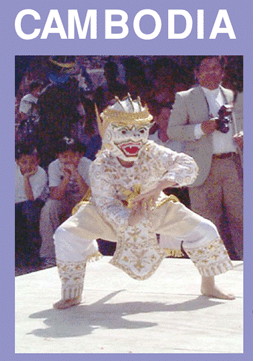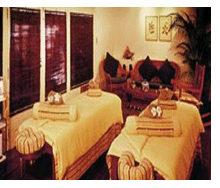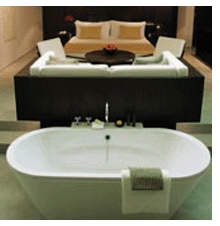|
|||||
| Cambodia, China, India, Indonesia, Japan, Malaysia, Maldives, Thailand, Vietnam, Singapore, Bali Cambodia • LIFE EXPECTANCY: 45 years average, low in World Health Organization documentation, due to the rural background of the majority of Cambodian population. • 95 % of Cambodians are Theravada Buddhists Tribal groups number less than 100,000 – world filled with invisible spirits often called yang • Theravada Buddhism is a tolerant, non-prescriptive religion that does not require belief in a supreme being. Its precepts require that each individual take full responsibility for his own actions and omissions  Healing Traditions of Cambodia – ”Kruu Healing Traditions of Cambodia – ”KruuKmer” Traditional Healers The civilization of the ancient Khmer in Cambodia is renowned for its extraordinary art and architecture of the sixth to the sixteenth centuries. Initially a collection of small kingdoms or city-states, Khmer society was increasingly consolidated over the course of the sixth century, when the earliest surviving works of sculpture were created. In the ninth century, Angkor emerged in the north as the capital of the unified kingdom of all "Kambuja," which gradually expanded into an empire encompassing much of present-day Thailand, Laos, and Vietnam. The three chief periods of Khmer civilization are defined in relation to this capital: pre-Angkor (before the 9th century), Angkor (9th-15th century), and post-Angkor (after the Thai invasion in 1431). The Khmer abandoned Angkor to the Thai in the fifteenth century and moved their capital south, near Phnom Penh, where they nonetheless preserved their cultural heritage. The Khmer empire created one of the world's most glorious traditions of sculpture and architecture. The hundreds of Hindu and Buddhist temples that were constructed at Angkor and throughout Cambodia reflect the strong influence of the culture and religions of India. In sculpture, Khmer artists demonstrated their technical mastery of stone carving and bronze casting, creating profoundly spiritual images of Hindu and Buddhist divinities. Most of the works of sculpture in this exhibition were made for temples and range from monumental cult statues to small offerings in bronze and narrative reliefs depicting scenes from Indian epics. The rich cultural heritage of Cambodia was nearly lost during the horrific destruction and genocide wrought by the Khmer Rouge during the "Killing Fields" of 1975-1979. The survivors, whether they have remained in Cambodia or have emigrated to other countries, carry both the deep scars of their war experience and a lasting pride in their cultural roots. The arts play a particularly important role in helping Cambodians reclaim their heritage and heal their souls for an emerging renaissance. Cambodian Healing Traditions • The traditional healers or “Kruu Khmer” specialize in medicinal practice with a spiritual component OR magic with a medicinal component • Techniques most commonly used are: - Kooi Kchall (coining) - rubbing wind out - Jup (cupping or pinching) - circular contusion - Oyt Pleung (moxibustion) - add chi or heat to area - Massage - Traditional or Natural Medicines - Coining = rubbing wind out of the skin, muscles or blood - Cupping = circular contusion when jar is placed over heat source on skin, oxygen is consumed and this creates a vaccum effect on the skin = circular contusion, which may result in bruising - Moxibustion = adds heat or chi/life force to an area or organ of the body Traditional healing or indigenous practices: Some of the following procedures are carried out by family members and some by traditional healers or Kruu Khmer. Some Kruu Khmer specialize in medicinal practice with a spiritual component, while others specialize in magic with a medicinal component. Regardless of who carries out the below or other procedures, they are often accompanied by prayer and other spiritual activities. Kooí'(rub) kchall (wind) is used to treat a variety of ailments, including fever, upper respiratory infection, nausea, weak heart, and malaise. A coin is dipped in Tiger Balm, Monkey Holding a Peach, Vick's Vapor Rub, or similar mentholated medicine. The coin is rubbed in one direction (away from the center of the body) on the patientís chest, back, and/or extremities. Kooí' kchall is usually referred to in western literature as "coining" or "dermabrasion." We recently encountered a woman with diabetic neuropathy who was coining her feet to treat the pain of the neuropathy! Jup (pinch) kchall is used to treat headache and malaise. The first and second fingers are used to pinch and thus bruise the bridge of the nose, neck, or chest. Jup also refers to the practice of "cupping" or placing a small candle on the forehead, lighting the candle, and placing a small jar over the candle. The flame consumes the oxygen and creates a vacuum, thus causing a circular contusion. As many as three contusions may be seen on a person’s forehead. Oyt pleung (known as "moxibustion" in the literature) is used to treat gastrointestinal and other disorders. Oyt pleung is seldom done in the U.S., but many adults will have four to six 1-2 cm round abdominal scars resulting from the procedure.  Grand Hotel d’Angkor Grand Hotel d’AngkorSpa treatments are a blend of traditional European techniques and therapies: aqua-therapy, hydrotherapy, aromatherapy, thalassic-therapy as well as facials, slimming and toning treatments. At the Amrita Spa, carefully selected treatments and therapies from around the world are heightened with traditional Khmer touches. In the fitness centre, guests can perfect the art of Khmer dancing, arise with early morning meditation, or enjoy the graceful disciplines of Yoga and Tai Chi in the outdoor Amrita Pavilion. After an exhilarating visit to the temples, tired muscles are tended to at the hands of professional therapists or in the modern hydrotherapy room.  Amansara Hotel Amansara HotelAman resort, primarily located in Asia, has an excellent approach to spa-ing which begins with their Name. Aman is derived from the Sanskrit “aman” which means peace. So begin with peace… Resorts begin with peace… Massage or manipulation is practiced by kruu Khmer and others. Traditional or natural medicines are available in stores and from individuals. Such medicines include a wide variety of plant (leaves, bark, extracts) and other substances. Some are brought to America (or even, occasionally, gathered in America) by individuals. Others are found pre-packaged and imported from Thailand or other Southeast Asian countries. These are often taken or applied topically in some combination of medicines and/or mixed with "wine" (usually vodka). We also sometimes encounter substances that may be classified as "Chinese medicine" such as those medicines/substances sold in Chinese pharmacies worldwide. It sometimes happens that Kruu will give medicines (often topical or magic in nature) to hospitalized patients. Spiritual healing practices: As noted above there are often both spiritual and medicinal elements in healing practices, hence classifying a particular practice as either spiritual or medicinal may not give a completely accurate picture of the practice. However, some illnesses or conditions are viewed as primarily or even only due to spirit problems or possession. Magico-religious articles such as amulets, strings, and Buddha images are common. Katha (amulets or what appears to be a piece of string) are commonly worn around the neck by children or around the waist by adults. Types of amulets include a small piece of metal inscribed with sacred words written in Pali and rolled around string, Buddha images attached to a gold chain, and braided knotted string (with the knots incorporating magical substances.) Amulets attain their power from prayers or incantations, from the words inscribed in the metal portion, from the material from which they are made, or from other attributes. Yuan (click to enlarge) are magical pictures/words placed over doors or sometimes folded in pockets. They usually are written in Pali. Buddha images may be seen as above or as statues or pictures in homes. They are found on altars placed high on a wall. Incense, flowers, food, cigarettes, or fetishes such as hair may also be placed on the altar. Tattoos are an older means of protection against harm or illness. Magical designs and/or words written in Pali are found on the chest, back, neck, and arms of some men. Other spiritual or magical means of treating illness include blowing on the sick person's body in a prescribed manner and showering or rubbing with lustral or blessed water. As noted earlier, many Khmer see no conflict in practicing or using traditional or magic means of treating illness simultaneously with western medicine. Many would further see no conflict in adding Christian prayer to the mix. © SPA MANAGEMENT JOURNAL - JANUARY 2006 |
|||||